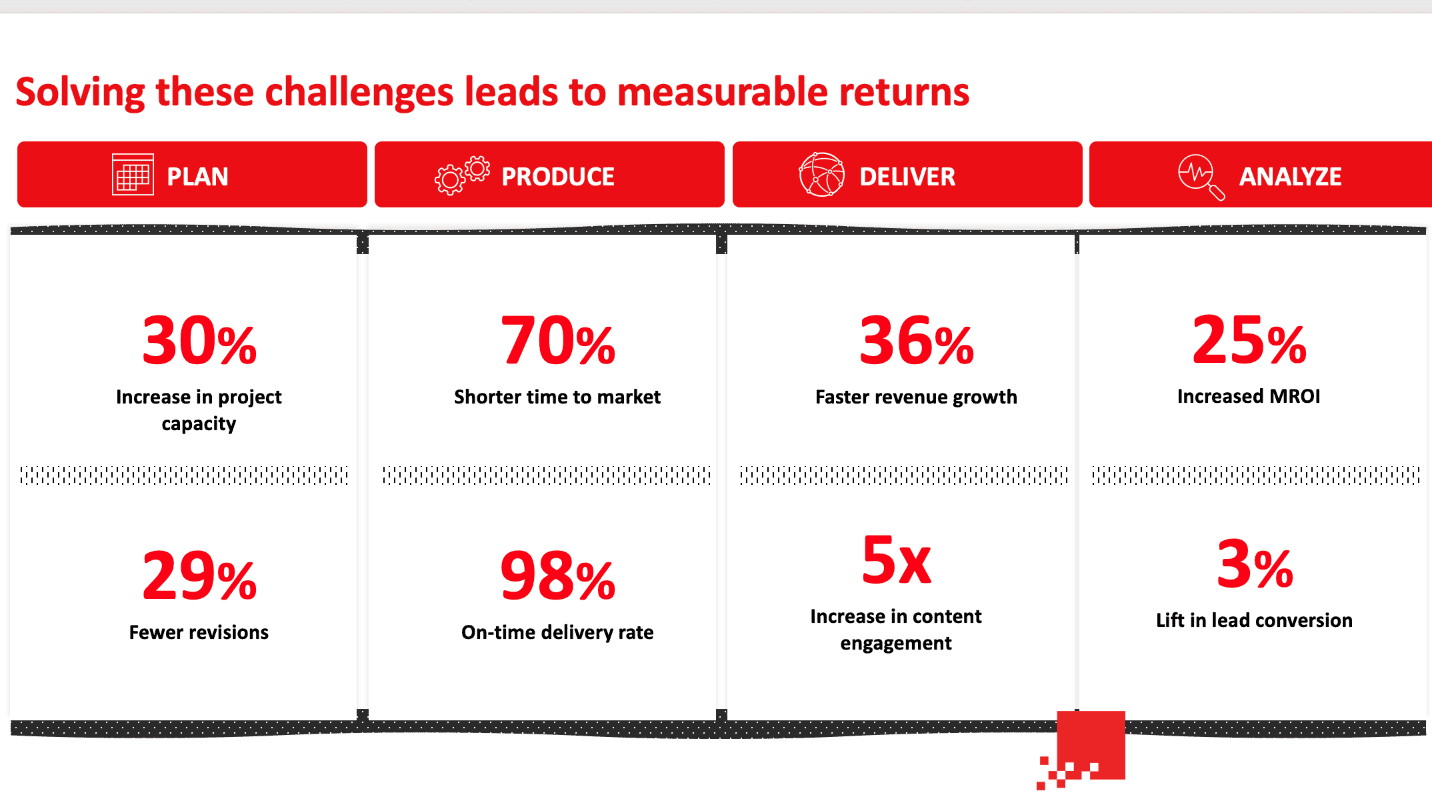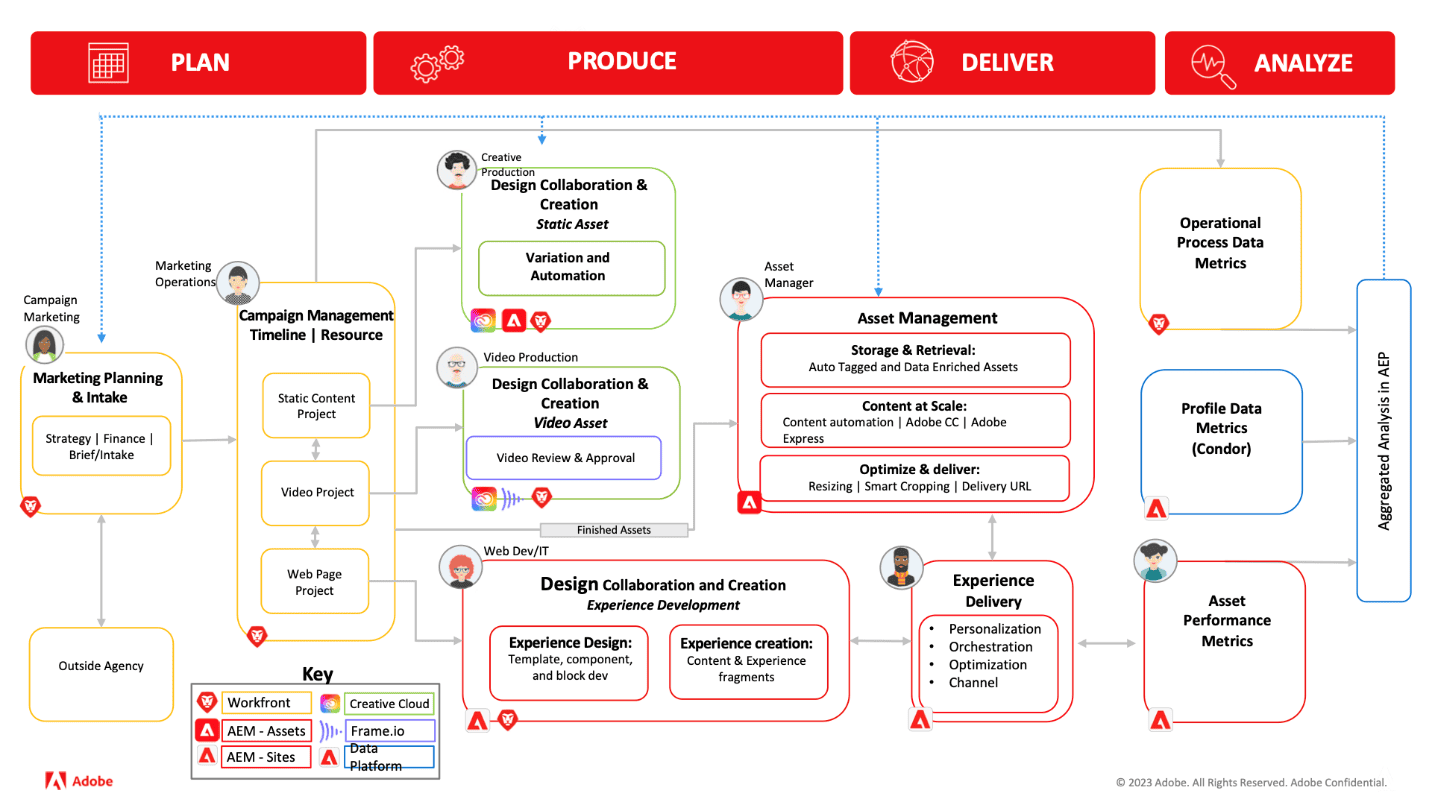Enhance Your Content Supply Chain: Scaling with Adobe’s Digital Asset Management (DAM)

Written by Poonam Chandersy
Technical Content Writer
July 27, 2023
In today’s fast-paced digital landscape, businesses face the challenge of managing and delivering a constant stream of content efficiently. To overcome this hurdle, a scalable content supply chain is essential. Enter Digital Asset Management (DAM), a powerful solution that revolutionizes content management, streamlines workflows, and enhances collaboration.
As businesses navigate the complexities of content creation and distribution, it is essential to leverage powerful tools and strategies. A prime example is Adobe’s Digital Asset Management, offering comprehensive solutions and empowering businesses to streamline their content supply chains and unlock the full potential of their digital assets. In this article, we will explore the various stages of a content supply chain and how integrating DAM can help businesses unlock scalability and efficiency.

Planning and Ideation
One of the key benefits of DAM is its ability to facilitate brainstorming and content planning. By leveraging DAM tools, businesses can centralize their content ideas, making it easier to collaborate and track progress. With a DAM platform, teams can access a centralized repository of assets, streamline ideation sessions, and ensure that content ideas are effectively captured and managed.
Content Creation and Collaboration
DAM tools play a vital role in streamlining content creation processes. They provide features such as version control, workflow management, and collaboration tools that allow teams to work seamlessly together. By integrating DAM into the content creation workflow, businesses can ensure all stakeholders have real-time access to the latest assets, collaborate effectively, and maintain consistency across their content.
Asset Management and Organization
Efficient asset management and organization are essential for a scalable content supply chain. DAM centralizes all digital assets, making it easy to search, retrieve, and reuse them. With robust tagging, categorization, and metadata management capabilities, DAM allows businesses to efficiently organize their assets and improve discoverability. This ensures that content creators can find the right assets when needed, eliminating time wasted on searching for files and reducing duplication of efforts.
Workflow Automation and Optimization
To achieve scalability, automation is key. DAM platforms can integrate with other tools and systems to automate repetitive tasks, such as file conversions, resizing images, or applying watermarks. By automating these processes, businesses can save time, reduce errors, and focus on creating high-quality content. Additionally, DAM enables the optimization of content workflows by providing visibility into bottlenecks and areas for improvement, leading to increased efficiency and productivity.

Review and Approval Processes
The review and approval cycles can often slow down content production. However, integrating DAM into these processes can significantly streamline them. DAM platforms offer features that allow stakeholders to provide feedback directly within the platform, eliminating the need for back-and-forth emails or meetings. This ensures a centralized feedback repository and facilitates efficient collaboration between content creators and reviewers.
Distribution and Publication
DAM seamlessly integrates with content management systems (CMS) to enable efficient content distribution. By connecting DAM with CMS platforms, businesses can easily publish content across various channels, ensuring consistent branding and messaging. With DAM’s ability to store and manage different versions of assets, businesses can effortlessly distribute content tailored to specific channels and audiences.
Performance Tracking and Analytics
Measuring the performance of content is crucial for optimizing future production and distribution efforts. DAM platforms provide analytics capabilities that offer insights into asset usage, content performance, and audience engagement. By leveraging DAM analytics, businesses can make data-driven decisions to enhance their content strategy, identify trends, and align their efforts with audience preferences.
Scaling and Growth Strategies
DAM enables scalability in the content supply chain by providing a centralized hub for assets, streamlined workflows, and automation. With DAM, businesses can easily expand their content operations without sacrificing quality. Strategies such as implementing standardized processes, leveraging metadata for scalability, and investing in training and support can further enhance the scalability and growth potential of the content supply chain.
Scaling DAM: Steps to Achieve Efficient Growth
Evaluate your current needs and challenges
- Identify pain points and inefficiencies in your existing digital asset management processes.
- Determine your goals for scaling, such as improving collaboration, increasing asset accessibility, or enhancing searchability.
Define your scaling objectives
- Clearly outline the desired outcomes and benefits you expect from scaling your DAM system.
- Align your objectives with your organization’s overall strategic goals.
Conduct a comprehensive DAM system audit
- Assess the current state of your DAM system, including its infrastructure, workflows, and asset organization.
- Identify areas that require improvement or adjustment to support scalability.
Plan for scalability
- Evaluate the scalability features and capabilities of your existing DAM solution.
- If needed, consider migrating to a more robust and scalable DAM system that can handle your growing asset library.
Review and optimize metadata and taxonomy
- Analyze your metadata structure and taxonomy to ensure it can accommodate future growth.
- Refine metadata standards and establish consistent guidelines for asset tagging and categorization.
Implement automated workflows
- Identify repetitive and time-consuming tasks that can be automated.
- Utilize workflow automation tools within your DAM system to streamline processes, such as file ingestion, metadata tagging, and approval workflows.
Enhance collaboration and user access
- Evaluate user roles and permissions to ensure appropriate access levels and permissions are assigned.
- Enable collaborative features, such as shared collections, annotations, and commenting, to facilitate efficient teamwork.
Explore integrations and APIs
- Identify opportunities to integrate your DAM system with other key tools and applications within your organization’s tech stack.
- Leverage APIs to enable seamless data exchange and workflow integration between different systems.
Regularly monitor and optimize performance
- Implement analytics and reporting features to track system performance, user engagement, and asset utilization.
- Continuously analyze data to identify bottlenecks, optimize workflows, and make informed decisions for future scalability.
Provide ongoing training and support
- Offer comprehensive training programs to ensure users understand the capabilities of the DAM system.
- Provide ongoing support to address user questions, troubleshoot issues, and encourage adoption.

Conclusion
Integrating Digital Asset Management (DAM) into your content supply chain can significantly enhance scalability and efficiency. Royal Cyber’s Adobe experts provide the required tools to streamline content creation, optimize workflows, and facilitate collaboration. Leverage DAM solutions, so you can unlock the full potential of your content supply chain, deliver high-quality content efficiently and stay ahead in the digital landscape.
Recent Blogs
- Middleware is often considered the glue that binds different systems and connecting platforms, and it …Read More »
- Learn to write effective test cases. Master best practices, templates, and tips to enhance software …Read More »
- In today’s fast-paced digital landscape, seamless data integration is crucial for businessRead More »



